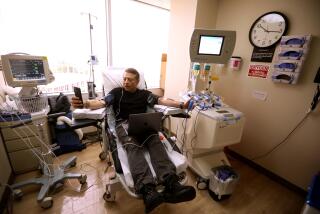Can scientists rejuvenate an aging brain with a protein found in umbilical cord blood?

Stanford University researchers gave three injections of human cord plasma to mice that were roughly the equivalent of 70 human years old. (April 20, 2017) (Sign up for our free video newsletter here http://bit.ly/2n6VKPR)
- Share via
What old brains need is a shot of young blood — and the younger the better.
It may sound like a metaphor employed by a randy octogenarian. But new research on mice suggests it can be taken quite literally.
Writing in the journal Nature, Stanford University anti-aging researchers reported Wednesday that they have found a “restorative factor for the aged hippocampus.” It’s a protein called tissue inhibitor of metalloproteinases 2, or TIMP2, that is found in the blood of young humans — and most copiously in umbilical cord blood.
Harvested at the time of an infant’s birth, cord blood is a rich source of many known regenerative substances, including hematopoietic stem cells, the kind found in bone marrow. Cord blood is capable of treating more than 80 diseases, including blood cancers, inherited blood diseases such as sickle cell and thalassemia, and a range of immune deficiencies.
In mice that were roughly the equivalent of 70 human years old, three injections of human cord plasma woke up a host of dormant genes in the brain. The injections also increased the flagging snap, crackle and pop of synapses in the hippocampus — a brain region that’s crucial to memory.
In addition, the cord blood improved the performance of aged mice as they engaged in memory and learning tasks, such as maze-running and fear-conditioning exercises.
Mice who got injections of blood from humans with a median age of 22 saw some but not all of these improvements, and they were more modest. But the unlucky mice that got blood from healthy “elderly” human subjects (with a median age of 66 years) saw no improvement at all.
The new study draws on a decades-old line of research called parabiosis, in which scientists lashed together the circulatory systems of young and old animals in a bid to mingle their blood and improve age-related decline in the older animal.
In a pathbreaking 2014 study, a team led by the senior author of the latest research, Stanford regenerative scientist Tony Wyss-Coray, showed that many of the beneficial effects seen from parabiosis experiments — including strengthened heart and other muscle tissue — could be had with repeated injections of plasma from young animals.
For the new study, Wyss-Coray’s team aimed to zero in on the precise components of blood that return an older body to youthful function — and to look for those so-called “factors” in human plasma. They focused on the hippocampus, a structure in the brain whose performance clearly suffers with age. Indeed, it is also one of the first points of attack when the brain comes under assault by diseases of age, such as Alzheimer’s.
An ordinary lab mouse would mount a massive immune response to the introduction of human blood in its veins, with certain fatal result. So to begin their explorations, Wyss-Coray’s team used mice bred to be immunodeficient. Then, after identifying proteins with potential regenerative powers, the researchers isolated them and tested them in ordinary, healthy mice.
So, what factor in the human cord blood was awakening the tired hippocampi of elderly mice? Solving that mystery required an exhaustive process of documenting, measuring and comparing concentrations of several proteins in the blood of mice and humans at different ages. Ultimately, the researchers began to observe that TIMP2 was especially plentiful in cord blood, but declined precipitously with age.
And when they saw that treatment with TIMP2 energized production of certain cells at the heart of the hippocampus, the researchers suspected they had their regenerative elixir. When they attached chemical tracers to the TIMP2 protein and injected it into the elderly mice, they could see it take up residence in the hippocampus, and saw that it “robustly increased” the electrical signals by which cells there communicate. And the older mice demonstrated improvements in learning and memory tasks.
Those behavioral improvements are hard to quantify, but amounted to a boost ranging from 30% to 50%, Wyss-Coray said.
“They don’t function like a young mouse,” he said. “But they maybe get halfway in that direction.”
Their improvements were especially evident in tasks involving spatial memory, an aspect of memory that suffers early in Alzheimer’s disease.
TIMP2 appears to have “quite an important function,” Wyss-Coray said, and “could almost be a master regulator” of processes that are key to aging. Other researchers, he noted, have explored its role in inhibiting the growth and spread of cancer, another disease of aging.
Finding that TIMP2 can alter the activity of the hippocampus as well as complex behavior in mice is a far cry from showing it can be an effective agent of neural regeneration in humans, Wyss-Coray said. But it’s an important waystation on the path to showing its potential in humans. The process of producing it in recombinant form, purifying it as a treatment, and testing it extensively in humans could take five to 10 years, he added.
Wyss-Coray co-directs Stanford’s Alzheimer’s Disease Research Center and is associate director of the Center for Tissue Regeneration, Repair and Restoration at the Palo Alto (Calif.) Veterans Affairs Health Service. He co-founded a company, Alkahest, that is conducting an early clinical trial in which plasma from young donors is intravenously administered to 18 people with mild to moderate Alzheimer’s disease. That trial is complete and the results are expected soon.
Click here for a Spanish version of this story
MORE IN SCIENCE
Why doctors are being urged to join the March for Science on Saturday
What would make a computer biased? Learning a language spoken by humans
Your fitness tracker can count your steps, but it’s not that good at monitoring your heart rate







